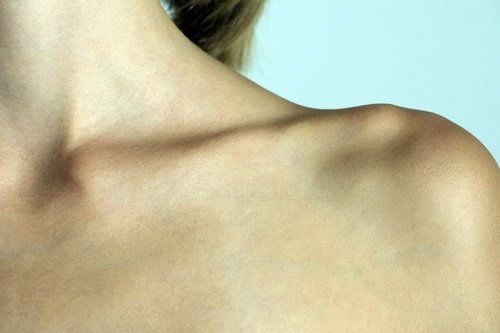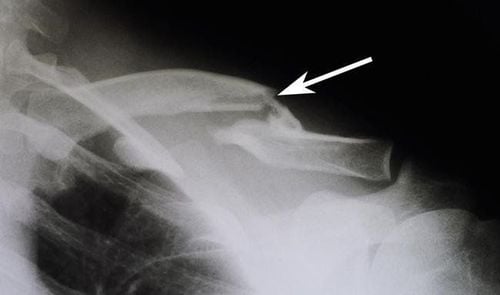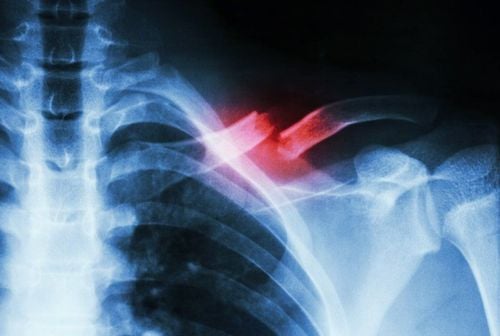This is an automatically translated article.
The article is professionally consulted by MSc, BS. Dang Manh Cuong - Radiologist - Radiology Department - Vinmec Central Park International General Hospital. The doctor has over 18 years of experience in the field of ultrasound - diagnostic imaging.Collar fractures are a common injury to the shoulder area. After examining to determine the status of clavicle fracture, the doctor gave an indication of chest X-ray to confirm the diagnosis of clavicle fracture, the degree of displacement as well as the associated lesions to give the appropriate treatment.
1. Learn about collarbone fractures
A broken collarbone, also known as the collarbone (the bone connecting the breastbone and shoulder blade) is the most common shoulder injury. Common in shoulder injuries in traffic accidents, daily life or sports accidents. Collar fractures have many dangerous complications, so it is necessary to check to identify complications due to clavicle fractures so that patients can be treated promptly. Displaced broken collarbone needs surgical intervention to avoid bone dislocation affecting mobility and aesthetics later. Treatment of clavicle fractures, whether conservative or surgical, should be monitored, re-examined, and x-rayed for early management of complications of fracture. When the image of the clavicle fracture has completely healed, the patient can gradually return to work and daily activities.2. Symptoms of collarbone fracture
Common symptoms of fractures are:Swelling and pain in the clavicle area, unable to raise the arm, shoulder drooping, especially pain increasing when moving the arm Bruising the injury area Stiffness, limited range of motion in the shoulder area receive fracture sound when moving the shoulder When pressed, it will feel sharp pain Deformed collarbone can be observed on the skin.

3. X-ray image of clavicle fracture
The straight clavicle x-ray technique is used when a patient has a suspected clavicle injury. This is a common injury accounting for 2.6-5% of fractures.After the clavicle fracture, the patient often has clinical symptoms of the above fracture, the specialist doctor will assign you to perform a straight clavicle x-ray to confirm the diagnosis.
Film result:
Film standard: Get the entire collarbone and both joints, the clavicle needs to be captured in the middle of the film, the film has contrast sharpness, the film is clean without scratches. Clavicle fracture is the discontinuity of the clavicle on the X-ray film of the clavicle, manifested by a fracture on the bone that is not displaced, the two ends of the fracture are still touching or the fracture causes displacement of the two ends of the bone far away from each other. into fractures of the lateral 13, the middle 1 and the 13 in the X-ray image shows whether the fracture is displaced or not, more or less displaced, has loose fragments or not Evaluates complications such as injury severe nerve damage, tearing or rupture of blood vessels combined with other types of fracture. From the results of the clavicle fracture and physical examination, the doctor prescribes treatment, including surgery, if the broken bone is displaced. Surgery will help straighten the broken bone and fix the broken bone in the best position while waiting for the bone to heal.

4. Complications of collarbone fracture
Complications in patients with clavicle fracture can be caused by the impact of traumatic force on the fracture site and surrounding soft tissue. Common complications of clavicle fractures such as:Slow bone healing: It is clear on X-ray film, after 3 months that the bone has not healed, it is necessary to monitor the condition of the bone slow to heal. To care for and recover from a fracture, choose foods that are good for bones, which will help the healing process take place faster. Non-healing bones: After 6 months, if the patient still has pain at the fracture site, has abnormal movements or on X-ray, there is no sign of bone healing, it is diagnosed as non-healing bone. : Due to the process of orthopedic or secondary displacements after orthopedic, bone fusion affects the function as well as Vascular damage such as laceration of blood vessels, causing more bleeding, more serious injury. Nerve damage: Fractures of the clavicle can cause contusions, tearing nerves, reducing the ability to move, eat, and feel in the limbs later on. Treatment of a clavicle fracture depends on the type of fracture and the severity of the fracture line. In patients with complex fractures, which are long or highly displaced fractures, surgery may be necessary. Collar fracture surgery will have the surgeon adjust the collarbone back to its normal position.
Straight clavicle x-ray technique is one of the techniques performed routinely at Vinmec International General Hospital. At the hospital, after clinical diagnosis, the hospital's doctors will perform a straight x-ray of the clavicle to determine the fracture line, location, nature, and displacement of the clavicle. From there, make appropriate treatment regimens, consider whether surgery is necessary or not.
Please dial HOTLINE for more information or register for an appointment HERE. Download MyVinmec app to make appointments faster and to manage your bookings easily.














